
Project outcomes always depend on how well you manage your time. It’s crucial to plan your resources effectively and then monitor their use on a daily basis. Otherwise, it will be pretty hard for to meet the set project goals on schedule and avoid major cost overruns.
actiTIME timesheet reports are exactly what you need to manage projects better! These reports depict insightful performance data, inform your time management decisions and help to maximize the chances for project success.
Let’s see how to use them and make your project management more efficient.
What Are Timesheet Reports in actiTIME?
actiTIME’s timesheet reports provide a comprehensive review of all your time tracking data, including overtime totals and time off summaries. With their help, it’s easy to analyze your personal or team performance, monitor the use of time across different projects and tasks, and see whether the predefined time estimates were met.
A full list of your reporting options in actiTIME is available on the Reports Dashboard:
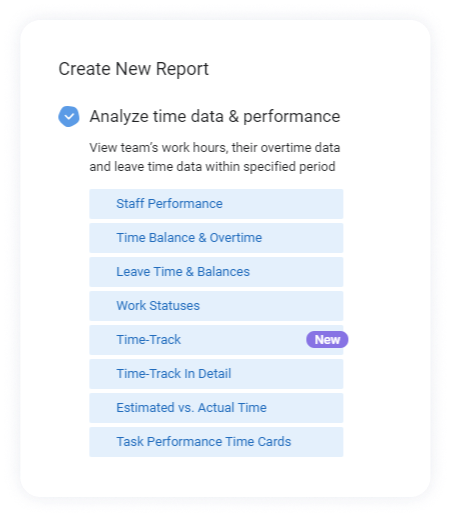
For each available timesheet report, you can set a preferred configuration filtering data by projects, teams, time periods, types of work, etc. It’s also possible to create shortcuts for your favorite reports. Simply save the preferable configuration to your dashboard and then generate the reports you need in merely one click.

You can choose any specific date range for your reports and compare trends with the same period in the past to get the dynamic picture.
The reports can include all data available to a manager or only show the data for specific parts of work and teams. They can be exported to CSV for further data processing or downloaded in PDF format.
How Do actiTIME Reports Help in Project Management?
- Improved time estimation | In actiTIME, you can track tasks against specific estimates. And by running a special report on estimated time, you will see how successful you are in meeting your time-bound performance objectives, evaluate your overall approach to task estimation and get informed to improve this process.
- Better resource management | actiTIME reports show you how well you utilize your working time every day. Reviewing them, you will identify which tasks take too long to complete, figure out why that happens and make necessary improvements accordingly.
- Efficient progress communication | Timesheet reports keep it clear who’s working on which task, what’s been already done and what’s left to do. You can configure them to include employees’ time tracking comments and see what they say about their daily work progress first hand.
Indispensable Timesheet Reports for Superior Project Results
Staff Performance Report
This report shows how much time your team spends on various work assignments. It allows managers to see who on their team has reported time, on what tasks, and how much time has been logged.
The report gives an overview of the team’s time expenses and helps reveal the most time-consuming parts of work. By providing information on how much time it takes to perform specific tasks, the report assists in estimating and planning upcoming project work.

Here’s how to use this report:
- Choose appropriate data grouping levels to make your report as detailed as necessary.
- Set a preferable date range to see how much time your employees tracked for that period.
- Group the data by customers or projects to see how many tasks were completed for each of them.
- Group the data by work types if you want to see which kinds of work consume the largest portion of your resources.
- Click on time entries highlighted with blue to see employees’ timesheet comments directly in the report.
- Break down users’ data by departments to review their subtotals and analyze the data in a more convenient way.
Time Balance & Overtime Report
It shows whether your employees work more or fewer hours a day / week than scheduled. By running the report, you will also find out how much overtime each employee has accumulated, which is crucial if you are legally obliged to provide workers with adequate overtime pay.
Time Balance & Overtime Report can be used to figure out employees and teams who are overloaded or, on the contrary, have low workloads. It fosters accurate accrual of overtime compensation in case your employees are paid for overtime at a higher rate.
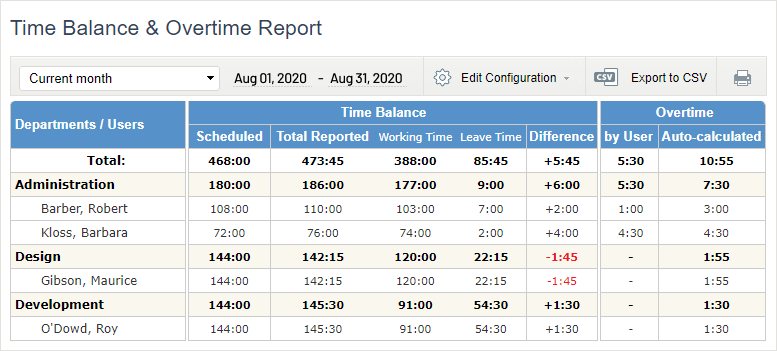
Here’s how to use this report:
- Group the data by users or departments to review scheduled vs. actually worked time for each employee or department.
- Group the data by months, weeks or days to see overtime summaries for a preferable period and use them for payroll calculation afterward.
- Include both the time balance and overtime data in the report or select only one of these parameters to avoid excessive details.
- Configure the report to display working hours and leave time in separate columns if you want the report to be as comprehensive as possible.
Leave Time & Balances Report
Leave Time & Balances Report demonstrates who was absent within a specific timeframe and how their absence affected their paid time off and sick days balances.
The report can be used to include paid leave data into payroll calculation, analyze team members’ absences, and detect and manage absenteeism issues (if any). One more important use case is handling unplanned absences: collecting the data and seeing the dynamics helps to make unscheduled absences more predictable and improve project workload management.
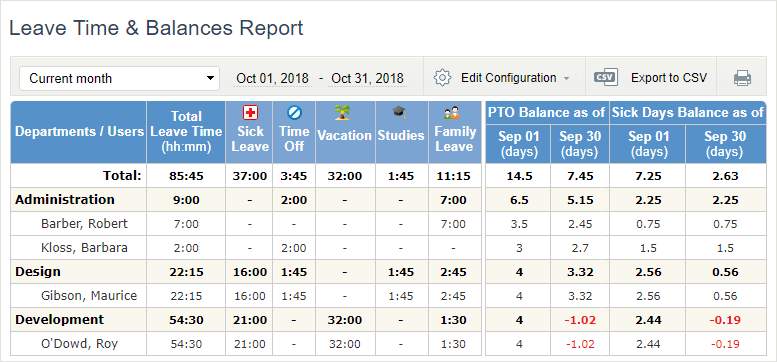
Here’s how to use the report:
- Group the data by users or departments to review individual and team absences for any specific period.
- Group the data by months, weeks or days to see absence totals for those periods and reveal absence dynamics.
- Generate the report for all leave types or only for specific ones. For example, running a report for less predictable leaves (e.g., sick leaves) gives insights into the frequency of unplanned absences in your team.
- Include leave time, paid time off and sick days balances in the report or exclude some of these parameters to prevent information overload.
Time-Track Report
This report lets project managers juggle and visualize the timesheet data in order to gain in-depth insights into their teams’ performance for the specified period and generate reports for internal and external use.
The report displays the time spent of various tasks within the selected period of time.
You can sort the data by tasks, projects, customers, date, etc., and filter it by users, customers, projects, and priority for granular analysis.
Another handy feature of the report is smart visualization allowing you to turn the data you arranged into a series of charts in a click of a button.

Here’s how to use the report:
- Use report data in its raw form for export and further processing;
- Filter the tasks by priority to see which project required most of your team members’ undivided attention;
- Filter the data to have only specific projects and clients displayed and export these in the desired format for reporting.
Time-Track In Detail Report
This report provides project managers and their teams with time tracking totals and all the details on how the scheduled work was performed within a selected date range. Its rich configuration options allow you to set up necessary levels of detail, group the data in many different ways and get the most value out of your timesheet data.
The report fosters an in-depth analysis of team performance and allows you to identify the most time-demanding parts of work. One of its most helpful features is users’ comments included directly in the report. It helps to reveal specific aspects of employees’ performance progress, understand which difficulties they’ve encountered, and figure out which of their work-related behaviors may require improvement.
Here’s how to use the report:
- Use report data in its raw form for export and further processing.
- Choose one of the three data grouping levels to make the report as detailed as you need.
- Join comments by tasks to get more information on specific work processes.
- Group the data by project and task names to get subtotals for similar parts of work.
- Group the data by types of work to identify which of them consume the majority of your time.
- Group the data by users and departments to see and analyze individual and collective results.
- Group the data by customers and projects to see time tracking totals for them.
Estimated vs. Actual Time Report
This report is one of the most helpful tools for project planning and forecasting. It shows how successful your team is in meeting the set project time estimates and indicates which percentage of the total estimate has been used.
Running this report after each completed part of work helps managers understand whether the estimates are often exceeded and try to figure out why that happens. By providing evidence on the actual number of hours spent on projects, the report assists in the planning and estimating of similar future projects and allows you to improve your time estimation results.
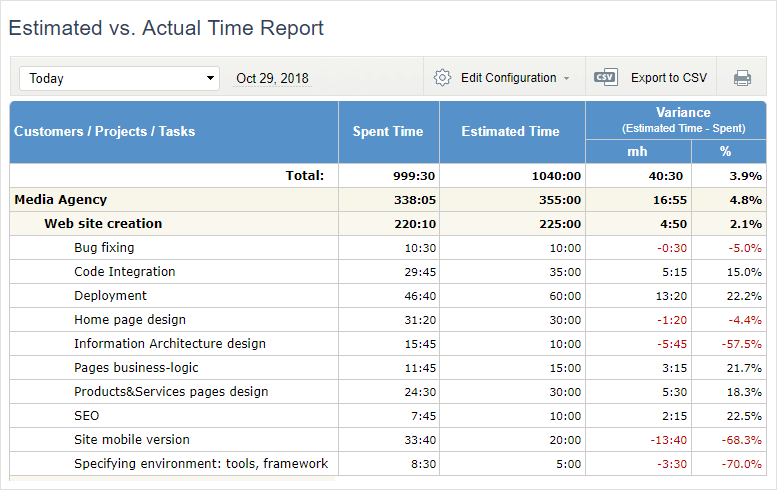
Here’s how to use this report:
- Configure the report to show time variance as of today or any date in the past.
- Use up to four data grouping levels to obtain the necessary level of detail in the report.
- Run the report for task with open and completed statuses together or for a specific progress status alone.
- Include the estimates of tasks that are not started yet to get a more comprehensive picture of your current work progress.
- Include time tracking data for tasks without estimates to see how much time they eat up and apply this info in future project planning.
Task Performance Time Cards Report
This report displays logged time intervals for tasks across clients and projects or any other custom work structure set up in the system.
If Calendar View is turned on in settings, the Task Performance Time Cards report becomes available in the time reports section. This report is indispensable for businesses looking to comply with local or state legislation and store the detailed breakdown of employee work. Its level of details is also essential for maintaining relationships with investors.
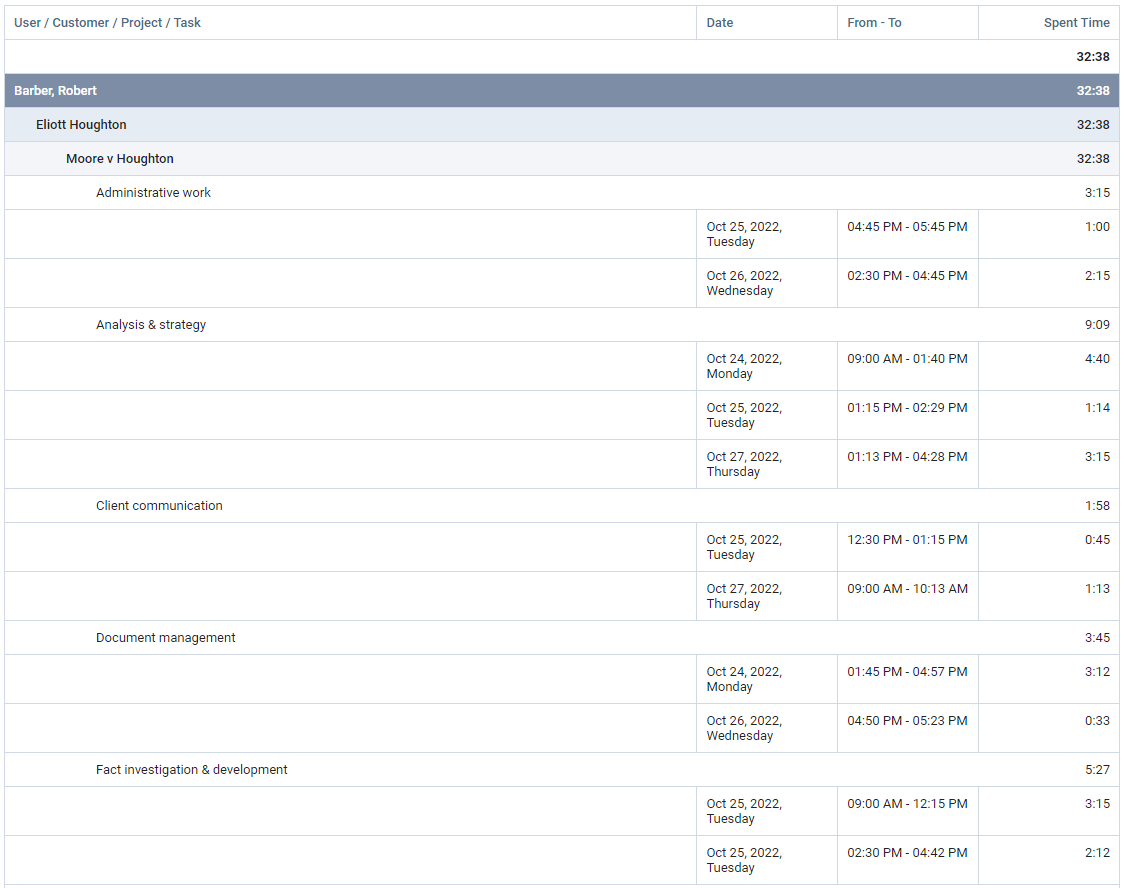
Here’s how to use this report:
- Choose a time period from the list or specify a custom one
- Select customers and projects to be displayed in the report
- Specify teams or individual users
- Adjust the report view using Filters, Data Grouping and Columns settings
- After you set up the report configuration, download it as a CSV file
- If you intend to refer to this report in the same configuration for different time periods, create its shortcut to put it on your report dashboard for quick access
What About Regular Users?
Regular users who don’t have any management privileges in actiTIME also can run personal timesheet reports in order to analyze their own performance results, optimize the use of time and find ways to improve productivity.
Also, each actiTIME user who can record their time has access to their own time tracking summary. It is available on the View Time-Track page:
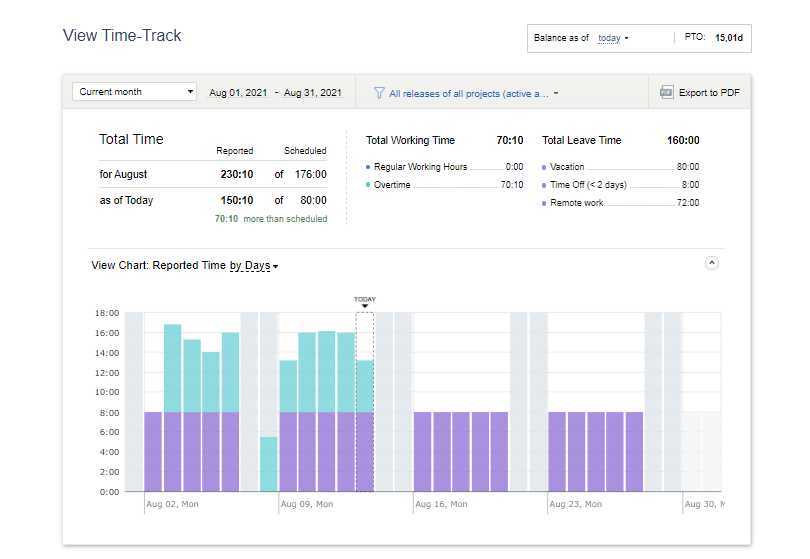
This interface provides the user with general data on how much of the scheduled time was utilized, how many absences were taken within the selected date range. actiTIME shows this data in an informative table and in a colorful chart and allows to export it in PDF format.
Summary
Timesheet data is a valuable source of information for project managers. It lets you see if your team uses its time efficiently, track work progress without a hitch and estimate tasks more accurately.
Use actiTIME to collect this data and improve your project management results with ease. Sign up for a free online trial today and give it a try.












































